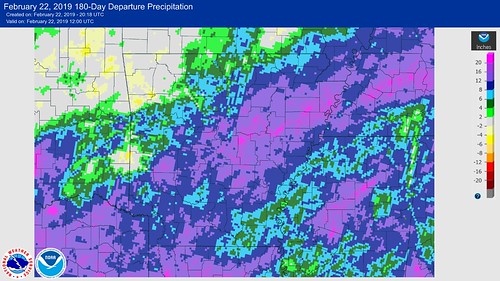As rains delay field prep, early planted rice looks increasingly less likely
By Ryan McGeeney
U of A System Division of Agriculture
Feb. 22, 2019
Fast Facts:
- Extension agents in many counties report most field prep remains incomplete
- Wet 2018 harvest left many fields rutted; will require additional tillage before planting
- Mississippi River likely to flood in some counties
(549 words)
(Newsrooms: Additional precipitation graphics available at https://flic.kr/s/aHsmvT3omJ)
(Download this story in MS Word format here.)
LITTLE ROCK – Continuously wet conditions further delayed the work of field preparation throughout much of Arkansas this week, as intermittent rains continue to saturate soils in the state.
At production meetings organized by the University of Arkansas System Division of Agriculture in January and February, both growers and agronomists have noted the delay in field preparation for the 2019 planting season. Jarrod Hardke, rice agronomist for the Division of Agriculture, said Friday that it appears increasingly unlikely that any growers in the state will be able to plant rice on March 15, typically the start of the early planting season.
“Assuming it ever stops raining, you’re looking at seven to 10 days of dry weather before you can get a tractor out in a field,” Hardke said. “Seventy percent of rice acres in this state are rotated with soybeans, and the vast majority of those soybean fields haven’t been worked in any manner.”
Friday morning, the National Weather service issued flash flood watches and warnings for more than 30 counties in the southeastern third of the state, from Chicot to Pulaski counties, and as far north as Mississippi County.
Many growers will need to till their fields to a significantly greater degree than in typical years, Hardke said, due to widespread rutting caused by the 2018 harvest.
“We’re not talking about standard tillage,” Hardke said. “This will require excessive tillage.”
According to data from the National Weather Service’s Little Rock station, every county in the southeastern half of Arkansas received 30-50 inches of rain between Aug. 22, 2018 and Feb. 22, 2019. The measured rainfall ranged from 110 to 200 percent of typical rainfall within the same six-month period.
Furthermore, many fields in the state likely still require fertilization.
Soil testing, which growers use to determine the nutrient needs of a field, typically precedes fertilization. Linda Moore, a technician with the University of Arkansas Soil Testing Laboratory in Marianna, Arkansas, said the laboratory had received about 13,800 soil samples from agricultural plots around the state from Jan. 22-Feb. 22, a notable decline from the norm, which is closer to 18,500 samples during the same period.
Robert Goodson, Phillips County extension agent for the Division of Agriculture, said most fields in his county are saturated, although water was draining well as of Friday morning.
"That has the possibility of changing,” he said. “The Mississippi River is at 43.8 feet, with a flood stage of 44.”
The river is predicted to crest at 47.5 feet on March 5.
Other rivers in the state are also at or near flood stage. Data from the National Weather Service show the Black River, measured at Corning in Clay County, at about 12 feet at of 3 p.m. Friday. Flood stage at that location is 15 feet. In Patterson, the Cache River, which floods at 9 feet, was also recorded at 12 feet. In White County, the White River was measured at Georgetown at 24.6 feet, more than 4 feet above flood stage.
“This is really affecting corn producers,” he said, adding that most corn in the county will probably need to be late-planted, if at all.
To learn about row crop agriculture in Arkansas, contact your local Cooperative Extension Service agent or visit www.uaex.uada.edu. Follow us on Twitter at @AR_Extension.
About the Division of Agriculture
The University of Arkansas System Division of Agriculture’s mission is to strengthen agriculture, communities, and families by connecting trusted research to the adoption of best practices. Through the Agricultural Experiment Station and the Cooperative Extension Service, the Division of Agriculture conducts research and extension work within the nation’s historic land grant education system.
The Division of Agriculture is one of 20 entities within the University of Arkansas System. It has offices in all 75 counties in Arkansas and faculty on five system campuses.
Pursuant to 7 CFR § 15.3, the University of Arkansas System Division of Agriculture offers all its Extension and Research programs and services (including employment) without regard to race, color, sex, national origin, religion, age, disability, marital or veteran status, genetic information, sexual preference, pregnancy or any other legally protected status, and is an equal opportunity institution.
# # #
Media Contact: Ryan McGeeney
Communication Services
U of A Division of Agriculture
Cooperative Extension Service
(501) 671-2120
rmcgeeney@uada.edu
